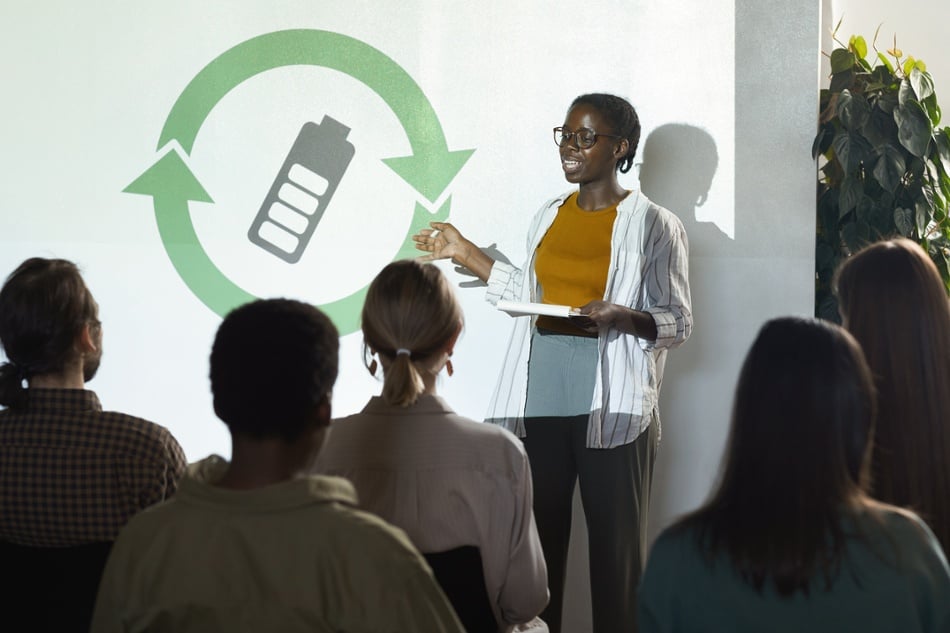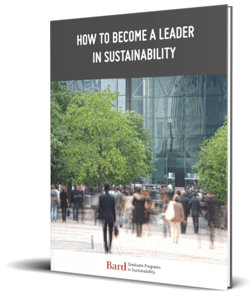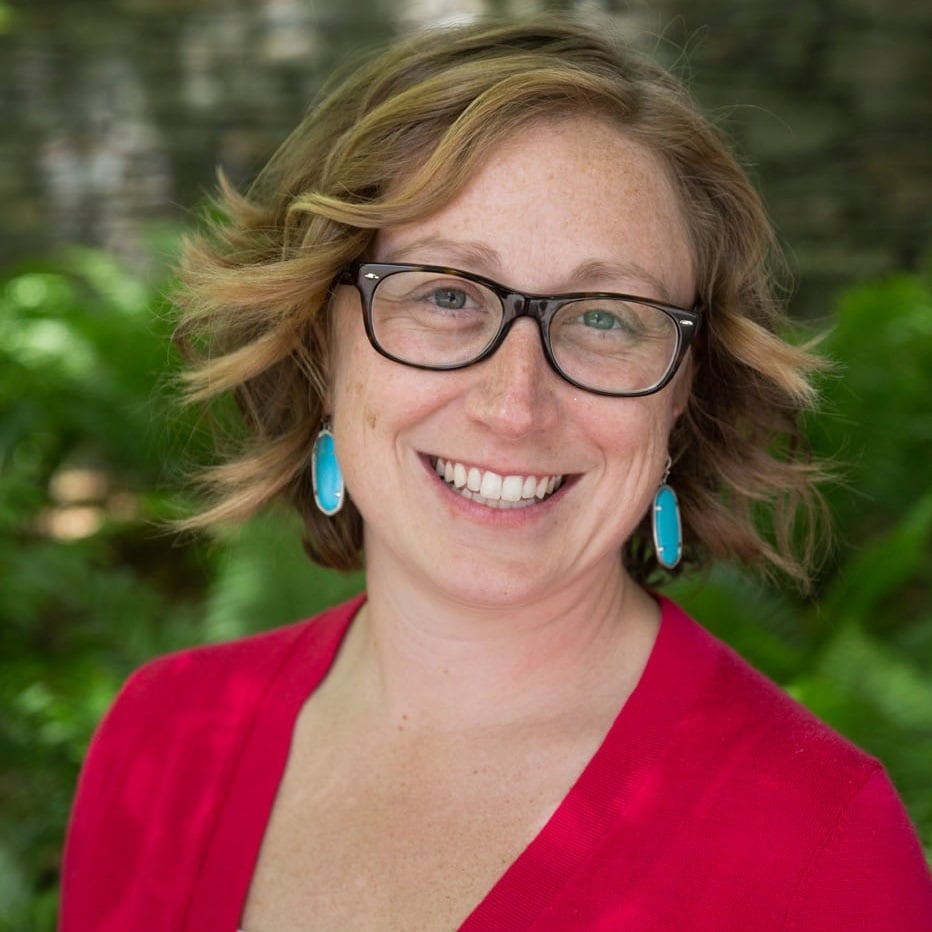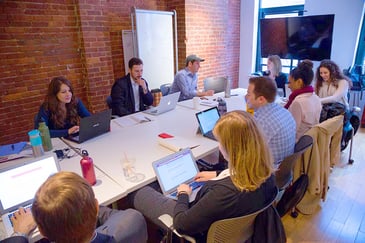6 Examples of World and Local Leaders in Sustainability

Many leaders see themselves in relation to the companies they work for; they lead this division—they’re in charge of that operation. They’re on top, and from there, they lead.
As we face challenges in global sustainability, we need a new kind of “leadership from the middle” — leadership that moves beyond individuals at the top of a hierarchy to distribute leadership opportunities broadly within organizations.
The next four decades will be the most important in human history. We are facing a global, environmental crisis. In the face of this enormous challenge, we need decisive, thoughtful action, and we need individuals who understand the kind of leadership required to solve these sustainability issues.
The Graduate Programs in Sustainability (GPS) at Bard teach leadership from the middle to the next generation of sustainability experts. Let’s dive deeper into what that sustainable leadership looks like, why it’s necessary for sustainability initiatives to succeed, and the global and local leaders in sustainability who are paving the way.
What is sustainable leadership?
Traditional leadership evokes the idea of a charismatic leader. But because sustainability challenges are so complex, uncertain, conflicted, and dynamic (i.e., “wicked”), they require a different approach: sustainable leadership. Under this approach, the basic elements of leadership are direction, alignment, and commitment. When these three elements align, then organizations can change direction.
In the shared leadership model, goals emerge from the stakeholders, who must hold themselves accountable for the future they create and the process for creating it. The difference is between employees following a leader’s vision, versus engaging with one another to face shared challenges.
Of course, there are models that lie between shared leadership and a vertical hierarchy. However, the more that leadership is shared, the more the role of the CEO, Division Head, or Director becomes that of a contributor, mentor, and coach. These leaders enable their teams to pave the way forward.
Let’s meet some of them.
Global and local leaders in sustainability
Sarah Kauss, S’well
It started with a hike, a single-walled water bottle, and a passing thought: “Wouldn’t it be great if there was a bottle that, first of all, looked better, but also worked better at the same time?”
Prior to that, there was a foundation of sustainability—concern born out of the Great Pacific Garbage Patch and the worldwide water crisis—but the hike was the spark that lit the match. And now Sarah Kauss’s S’well is the fastest growing woman-owned business in the United States.
“At S’well, I like to say we’re light green, not dark green,” she says. “We’re green all the way through, but we really had to think about starting with something that’s designed very well, something that’s beautiful and appeals to a broad swath of a consumer base. It has the goal of getting more people to use it because of the look, and what it does for you, and how you feel about it. Because of that, more and more customers are using the product, and the outcome is that it’s better for the planet.”
Tom Szaky, Terracycle
Since 2001, Terracycle has been taking hard-to-recycle waste and turning it into raw material for use in new products. But Terracycle didn’t have the most graceful of beginnings.
Founder and CEO, Tom Szaky, started the company by selling worm poop tea as a fertilizer. Because he had little money to work with, he used discarded plastic soda bottles as packaging. The product gained some minor popularity, and Szaky gained shelf space in big box retailers like Home Depot. From there, Szaky started thinking more deeply about what we throw away—and what he could make out of it. Thus, Terracycle was born.
Fast forward to today, and Terracycle operates in more than 20 countries. They partner with organizations like Proctor & Gamble (P&G), Mars, Nestlé, and Unilever to generate ultra-durable packaging forms that will be owned by the manufacturer and loaned to the consumer. They were even recognized by the United Nations with the Momentum for Change Lighthouse Award.
In an industry that isn’t very innovative, Szaky knows what it takes to lead sustainability. He says, “What we do is think about everything in a slightly different way. Today, waste management companies make their profit through disposal—they look at waste as a liability. What we look at is, ‘What are all the possible points of value beyond just the material value of the waste stream?’ So, could there be reputational value and could it drive foot traffic? There are whole sets of exciting outcomes and ways to monetize waste. That philosophy is the lens we bring to the question.”
Lily Trager, Morgan Stanley
Executive Director, Director of Investing with Impact, and Head of Impact Solutions, Lily S. Trager brings a lot of benefit to Morgan Stanley Wealth Management. Since 2006, Lily has dedicated her career to sustainable and impact investing.
In 2009, Morgan Stanley shifted their priorities to sustainable and impact investing through the visionary leadership of James Gorman, Chairman and CEO, and Audrey Choi, Chief Sustainability Officer and Chief Marketing Officer. Together, they launched global sustainable finance at the firm level to build a focus and strategy across all of the businesses, weaving sustainable and impact investing into the core capabilities of Morgan Stanley.
Lily says, “If you think about the timing on that, right, with the Great Recession in 2008, the timing was really remarkable, because it showed a commitment from the highest levels of leadership across our firm to sustainable and impact investing as a future growth driver of our business—at a time when most of our competitors were ultimately reducing their resource allocation.”
Lily was named to the 2018 class of MAKERS @ Morgan Stanley Wealth Management, a recognition that celebrates women who are ground breakers, advocates, and innovators in their given field.
Roger McClendon, Green Sports Alliance
Roger has been the Executive Director of the Green Sports Alliance since 2019. Prior to that, he spent 14 years working at Yum! Brands, but he transitioned into the niche world of green sports, because, “My roots are in sports. Even during my career with Yum!, I recognized that sports could play a major role in sustainability."
As he sees it, corporations and sports groups have a natural collaborative relationship. They can grow business together and also promote the right behaviors. Think of the operations and food that are involved in a venue like a stadium. Green Sports Alliance works with big organizations like Aramark to provide a great fan experience; they need to ensure the products served are high quality and from a sustainable source, and they also need to monitor the supply chain process. They don’t want any waste, and they also need to keep it affordable. There’s a lot to consider.
“If you think about leveraging technology and innovation, a lot of times you can keep the triple bottom line. I live by that, and it’s really important for sustainability managers, who have the right language and the right approach, to engage. By benchmarking, networking, learning best practices, and applying technology in the right way, you can drive a lot of wins.”
Ali Kenney, Burton
Building sustainability into an already existing organization isn’t easy, but that’s just what Ali Kenney, VP of Global Strategy and Insights at Burton, did. Now, she drives the sustainability strategy and platform for the company’s portfolio of brands.
Burton is known as a snowboarding company: half their business is in snowboarding hard goods; part is in soft goods (fleece, jackets, hoodies, socks, and hats, to name a few); and another part can be found in creating experiences. Ali led the sustainability team in meeting their 2020 goals: 100 percent Fair Labor Association compliance in Burton’s factories, carbon-neutral Burton U.S. Open Snowboarding championships, to innovations at the end of a snowboard’s life—an item traditionally not thought to be recyclable.
But these strides in sustainability are not just because of Ali’s leadership. In fact, her strategy is all about empowerment. She says, “I didn’t want to create a bloated sustainability bureaucracy, so it’s all about getting the internal experts we already have to continue to be the experts and execute on the goals. Our sustainability team is really set up to guide everyone and set the vision, set the strategy.”
Talk about sustainable leadership in action. Listen to Ali talk about sustainability initiatives at Burton below.
Mitchell Silver, Commissioner of NYC Parks & Recreation
Silver became Commissioner of the New York City Department of Parks and Recreation in May 2014. An award-winning planner with more than 30 years of experience, he oversees nearly 30,000 acres of parkland, which includes parks, playgrounds, beaches, marinas, recreation centers, wilderness areas, and other assets.
Parks became even more important during the COVID-19 pandemic, being one of the only places people could go outside of their homes. After the murder of George Floyd and the calls for justice and police reform began, the Parks Department came together in a special way thanks to Silver’s leadership.
“Being a black man, it was an awakening for me, as well. I wrote a message to our staff about how a scab was ripped off. You know, being at my age and suppressing your identity for so long, it was a sense of freedom where I now can speak out and feel I don't have to check my black identity at the door. So, I shared my feelings with staff to let them know they were not alone, that I stand in solidarity with the black community and Black Lives Matter.
I’m a runner; I did a lot of running protests, as well as other protests. And my staff was like, ‘Commissioner, why didn’t you tell us? We would have been right there by your side.’ That was touching. And so I decided to have a reflection with my staff.”
Hear more about how Silver led the NYC Department of Parks and Recreation through the COVID-19 pandemic in the podcast below.
Becoming a leader in sustainable business
Our world depends on those who champion sustainability in the business world. Some brands and big companies are slowly embracing the shift to corporate sustainability models. However, many organizations still treat sustainability as an afterthought.
People who are passionate about the environment, entrepreneurship, and social responsibility can get the tools they need to be a leader in sustainable business with a master’s degree in sustainability.
Bard offers an MBA in Sustainability that teaches leadership from the middle and provides a program with a strong foundation of sustainability, not just a specialized class or two. We know that the next generation of leaders need to consider the integrated bottom line (also known as triple bottom line sustainability), and that’s how our students learn to approach business. After all, business can be a positive force in the world when our leaders can think beyond profit.
Interested in learning more about Bard’s MBA in Sustainability or any of our other sustainability programs? Contact an admissions counselor for more information.
As we face global sustainability challenges, we need a new kind of "leadership from the middle”.






-1.jpg?width=365&name=IMG_7806%20(1)-1.jpg)
